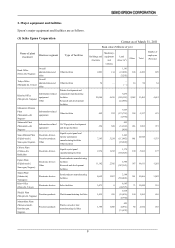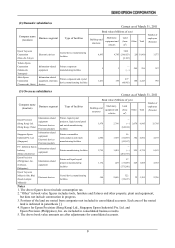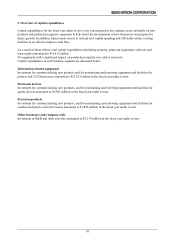Epson 2011 Annual Report Download - page 18
Download and view the complete annual report
Please find page 18 of the 2011 Epson annual report below. You can navigate through the pages in the report by either clicking on the pages listed below, or by using the keyword search tool below to find specific information within the annual report.
17
if such a problem in quality arises with respect to Epson products, Epson might lose the trust of others in its
products, lose major customers or experience a drop in demand for those products, any of which might
adversely affect Epson’ s operating results.
17. Epson is vulnerable to risks of problems arising relating to the environment.
Epson is subject, both in Japan and overseas, to various environmental regulations concerning industrial waste
and emissions into the atmosphere that arise from manufacturing processes. Environmental conservation is one
of Epson’ s most important management policies, and the Company is proactively engaged in environmental
conservation on all fronts. For example, Epson has programs to develop and manufacture products that have a
smaller environmental burden, reduce energy use, promote the recovery and recycling of end-of-life products,
and improve environmental management systems. To date, Epson has not had any serious environmental issue,
but there is a possibility that in the future Epson might be affected by a compensation claim, incur expenses
(such as cleaning expenses), receive a fine, be ordered to cease production or be otherwise affected as a result of
environmental damage or that new regulations might be brought in requiring Epson to pay considerable
expenses, and, if such a situation should occur, Epson’ s operating results could be adversely affected.
18. Epson is vulnerable to proceedings relating to antitrust laws and regulations.
With business operations that span the globe, Epson is subject in Japan and overseas to proceedings relating to
antitrust laws and regulations, such as those prohibiting private monopolies and those protecting fair trade.
Overseas authorities sometimes investigate and gather information on certain industries and as part of this,
Epson’ s market conditions and sales methods may come under investigation. Such investigations and
proceedings could obstruct Epson’ s sales activities and adversely affect Epson’ s operating results.
19. Epson is at risk of material legal actions being brought against it.
Epson conducts businesses internationally. Its primary businesses are the development, manufacture and sale of
information-related equipment, electronic devices and precision equipment. Given the nature of its businesses,
there is a possibility that an action could be brought or legal proceedings could be started against it regarding,
for example, intellectual property rights, product liability, antitrust laws or environmental regulations.
As of the date it submitted its Annual Securities Report, Epson was contending the following material actions.
In Germany, the organization for collecting copyright fees on behalf of copyright holders,
Verwertungsgesellschaft Wort (“VG Wort”), has brought a series of legal actions seeking payment of copyright
fees against importers and venders of PCs, printers and other digital equipment that is capable of reproducing
copyrighted works.
In January 2004 VG Wort brought a civil action against Epson Deutschland GmbH (“EDG”), a consolidated
subsidiary of the Company, to seek payment of copyright fees on single-function printers. The initial judgment
determined that the aforementioned printer is subject to a copyright fee and decreed that EDG pay the fee at a
rate of between 10 to 256.70 euros per printer depending on the printer’ s printable pages per minute. However,
the claim was dismissed by the appeals court and the supreme court. The plaintiff, however, unsatisfied with
this ruling, appealed to the Federal Constitutional Court of Germany. On December 21, 2010, the Federal
Constitutional Court ruled that the August 2008 ruling of the supreme court violates rights set forth in Article 14
of the constitutional law of Germany. It thus dismissed the August 2008 ruling of the supreme court and
referred the case back to the supreme court for review. Companies in general, including Epson, and industry
organizations are showing a willingness to take a stance against the expansion of the scope of such copyright
fees.
Apart from this, civil actions have been brought against the Company and certain of its consolidated
subsidiaries by multiple customers in multiple countries, including the United States, regarding allegations of
involvement in a liquid crystal display price-fixing cartel. It is difficult at this time to predict the outcome of
these civil actions and when they may be settled, but Epson's operating results and future business could be
affected, depending on the outcomes of suits and legal proceedings.
20. Epson is vulnerable to certain risks in internal control over financial reporting.
Epson has established and operates internal control with the aim of ensuring the effectiveness and efficiency of
business operations, reliability of financial reporting, compliance with applicable laws and regulations relevant
























